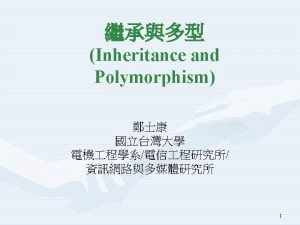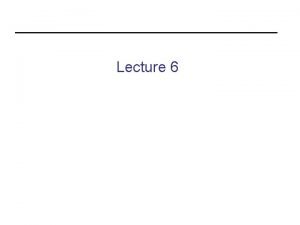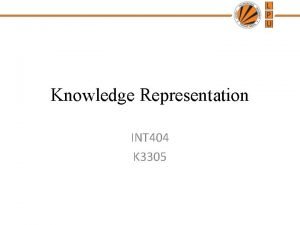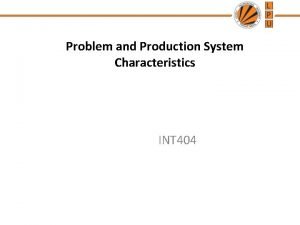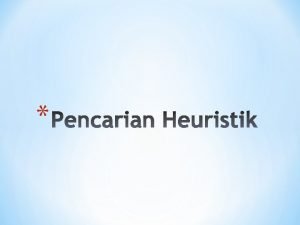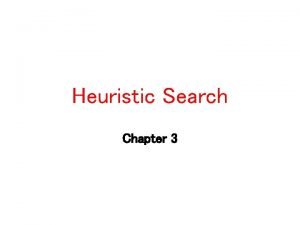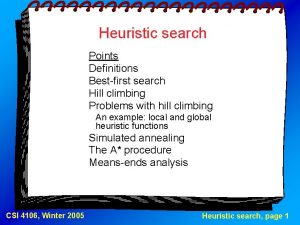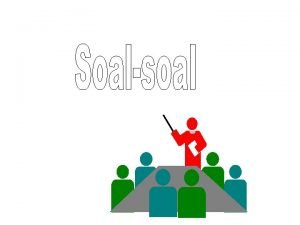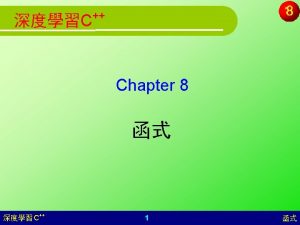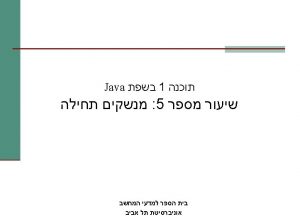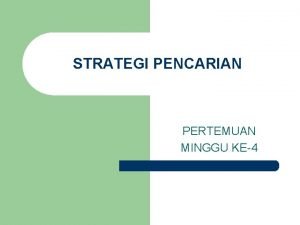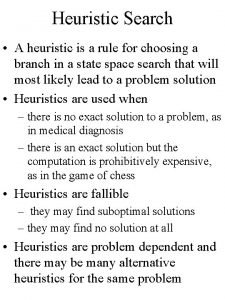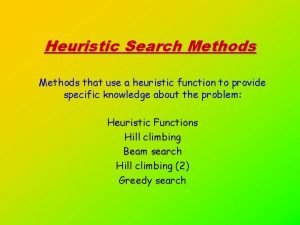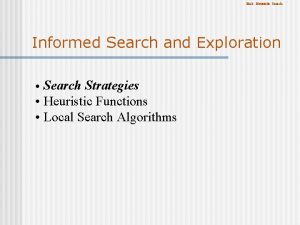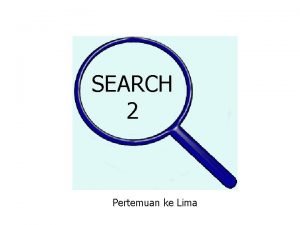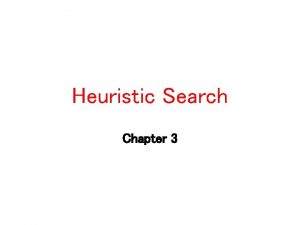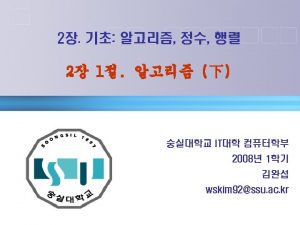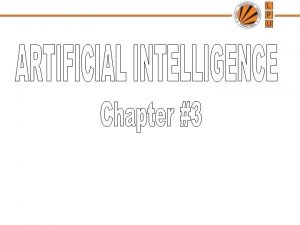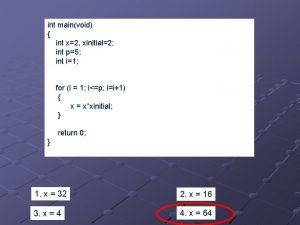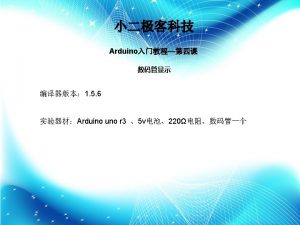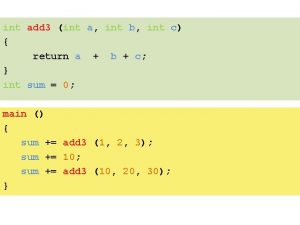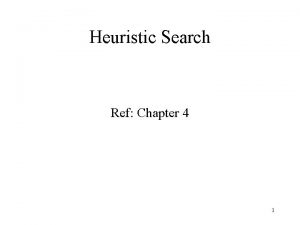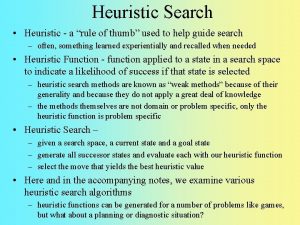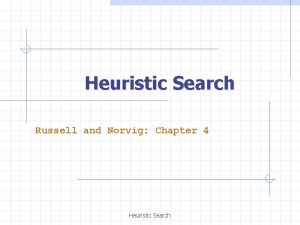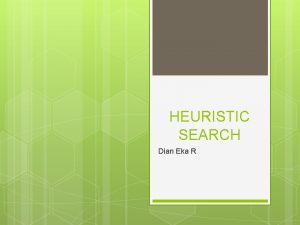Heuristic search INT 404 Heuristic search Generateandtest Hill
























- Slides: 24

Heuristic search INT 404

Heuristic search Generate-and-test Hill climbing Best-first search Problem reduction Constraint satisfaction Means-ends analysis 44

Algorithm : Generate-and-Test 1. Generate a possible solution. 2. Test to see if this is actually a solution by comparing the chose point or the endpoint of the chosen path to the set of acceptable goal states. 3. If a solution has been found, quit. Otherwise, return to step 1. 45

GENERATE-AND-TEST Acceptable for simple problems. Eg : 1. finding key of a 3 digit lock. 2. 8 -puzzle problem Inefficient for problems with large space. Use DFS as all possible solution generated, before they can be tested. It is simply an exhaustive search of problem space. 4

GENERATE-AND-TEST Generate solution randomly: British museum algorithm; wandering randomly Exhaustive generate-and-test. : consider each case in depth Heuristic generate-and-test: not consider paths that seem unlikely to lead to a solution. Plan generate-test: �� Create a list of candidates. �� Apply generate-and-test to that list on the basis of constraintsatisfaction. 5

HILL CLIMBING Generate-and-test + direction to move (feedback from test procedure). Test function – responds with only yes and no. Heuristic function (objective function) to estimate how close a given state is to a goal state. Test function + heuristic function = Hill Climbing Hill climbing is often used when a good heuristic function is available for evaluating states but when no other useful knowledge is available. 6

SIMPLE HILL CLIMBING Evaluation function as a way to inject task-specific knowledge into the control process. Key difference between Simple Hill climbing and Generate-and-test is the use of evaluation function as a way to inject task specific knowledge into the control process. Better : higher value of heuristic function Lower value 7

Algorithm : Simple Hill-Climbing 1. Evaluate the initial state. If it is also a goal state, then return it and quit. Otherwise, continue with the initial state as the current state. 2. Loop until a solution is found or until there are no new operators left to be applied in the current state: (a) Select an operator that has not yet been applied to the current state and apply it to produce a new state. (b) Evaluate the new state. (i) If it is a goal state, then return it and quit. (ii) If it is not a goal state but it is better than the current state, then make it the current state. (iii) If it is not better than the current state, then continue in the loop. 46

EX 1) 2) Use heuristic function as measure of how far off the number of tiles out of place. Choose rule giving best increase in function. 2 8 3 1 6 4 7 5 1 2 3 8 4 7 6 5

Example -4 -3 U 2 8 3 1 6 4 7 5 2 3 1 8 4 7 6 5 copyright 2005 reserved all rights U 2 8 3 1 4 7 6 5 -2 -3 -1 D L. Manevitz 1 2 3 8 4 7 6 5 Lecture 2 L 2 3 1 8 4 7 6 5 0 R 1 2 3 8 4 7 6 5 10

STEEPEST-ASCENT HILL CLIMBING Considers all the moves from the current state. Selects the best one as the next state. Also known as Gradient Search. 11

Algorithm : Steepest-Ascent Hill Climbing or gradient search 1. Evaluate the initial state. If it is also a goal state, then return it and quit. Otherwise, continue with the initial state as the current state. 2. 2. Loop until a solution is found or until a complete iteration produces no change to current state: (a) Let SUCC be a state such that any possible successor of the current state will be better than SUCC. (b) For each operator that applies to the current state do: (i) Apply the operator and generate a new state. (ii) Evaluate the new state. If it is a goal state, then return it and quit. If not, compare it to SUCC. If it is better, then set SUCC to this state. If it is not better, leave SUCC alone. (c) If the SUCC is better than current state, then set current state to SUCC. 47

HILL CLIMBING: DISADVANTAGES Fail to find a solution Either Algo may terminate not by finding a goal state but by getting to a state from which no better state can be generated. This happen if program reached Local maximum: A state that is better than all of its neighbours, but not better than some other states far away. Plateau: A flat area of the search space in which all neighbouring states have the same value. Ridge: Special kind of local maximum. The orientation of the high region, compared to the set of available moves, makes it impossible to climb up. 13

Hill-Climbing Dangers Local maximum Plateau Ridge 48

HILL CLIMBING: DISADVANTAGES Ways Out Backtrack to some earlier node and try going in a different direction. (good way in dealing with local maxima) Make a big jump to try to get in a new section. (good way in dealing with plateaus) Moving in several directions at once. (good strategy for dealing with ridges) 15

HILL CLIMBING: DISADVANTAGES Hill climbing is a local method: Decides what to do next by looking only at the “immediate” consequences of its choices rather than by exhaustively exploring all the consequences. Global information might be encoded in heuristic functions. 16

A Hill-Climbing Problem Local: Add one point for every block that is resting on thing it is supposed to be resting on. Subtract one point from every block that is sitting on wrong thing. 4 8 49

Three Possible Moves (a)=4 (b)=4 (c)=4 50

Three Possible Moves Global: Add one point for every block in correct support structure, subtract one point for every block in existing support structure. (1=b , 2=c) -21 -16 -15 50

SIMULATED ANNEALING A variation of hill climbing in which, at the beginning of the process, some downhill moves may be made. To do enough exploration of the whole space early on, so that the final solution is relatively insensitive to the starting state. Lowering the chances of getting caught at a local maximum, or plateau, or a ridge. The term simulated annealing derives from the roughly analogous physical process of heating and then slowly cooling a substance to obtain a strong crystalline structure. The simulated annealing process lowers the temperature by slow stages until the system ``freezes" and no further changes occur. 20

SIMULATED ANNEALING Probability of transition to higher energy state is given by function: P = e –∆E/k. T Where ∆E is the positive change in the energy level T is the temperature K is Boltzmann constant. Suppose k=1, P’ = e –∆E/k. T Annealing schedule: if the temperature is lowered sufficiently slowly, then the goal will be attained. 21

Algorithm : Simulated Annealing 52

SIMULATE ANNEALING: IMPLEMENTATION It is necessary to select an annealing schedule which has three components: Initial value to be used for temperature Criteria that will be used to decide when the temperature will be reduced Amount by which the temperature will be reduced. 23

n a Th ! ! ! u o Y k
 Int sum(int a int n) int sum=0 i
Int sum(int a int n) int sum=0 i Interface calculator public int add class test
Interface calculator public int add class test Public void drawsquare(int x, int y, int len)
Public void drawsquare(int x, int y, int len) Divideint
Divideint Int max(int x int y)
Int max(int x int y) Int404
Int404 Int 404
Int 404 Characteristics of system
Characteristics of system Blind search dan heuristic search
Blind search dan heuristic search Hill climbing heuristic
Hill climbing heuristic Hill climbing heuristic
Hill climbing heuristic Void swap(int a int b)
Void swap(int a int b) #include stdio.h int main() int i = 5
#include stdio.h int main() int i = 5 Void f(int i) int j=0
Void f(int i) int j=0 Arduino const
Arduino const 7팩토리얼
7팩토리얼 Max int
Max int Interface myinterface int foo(int x)
Interface myinterface int foo(int x) Int main int num 4
Int main int num 4 Char argv
Char argv Int main int argc char argv
Int main int argc char argv Search strategy
Search strategy Heuristic search
Heuristic search Heuristic search methods
Heuristic search methods Informed (heuristic) search strategies
Informed (heuristic) search strategies

